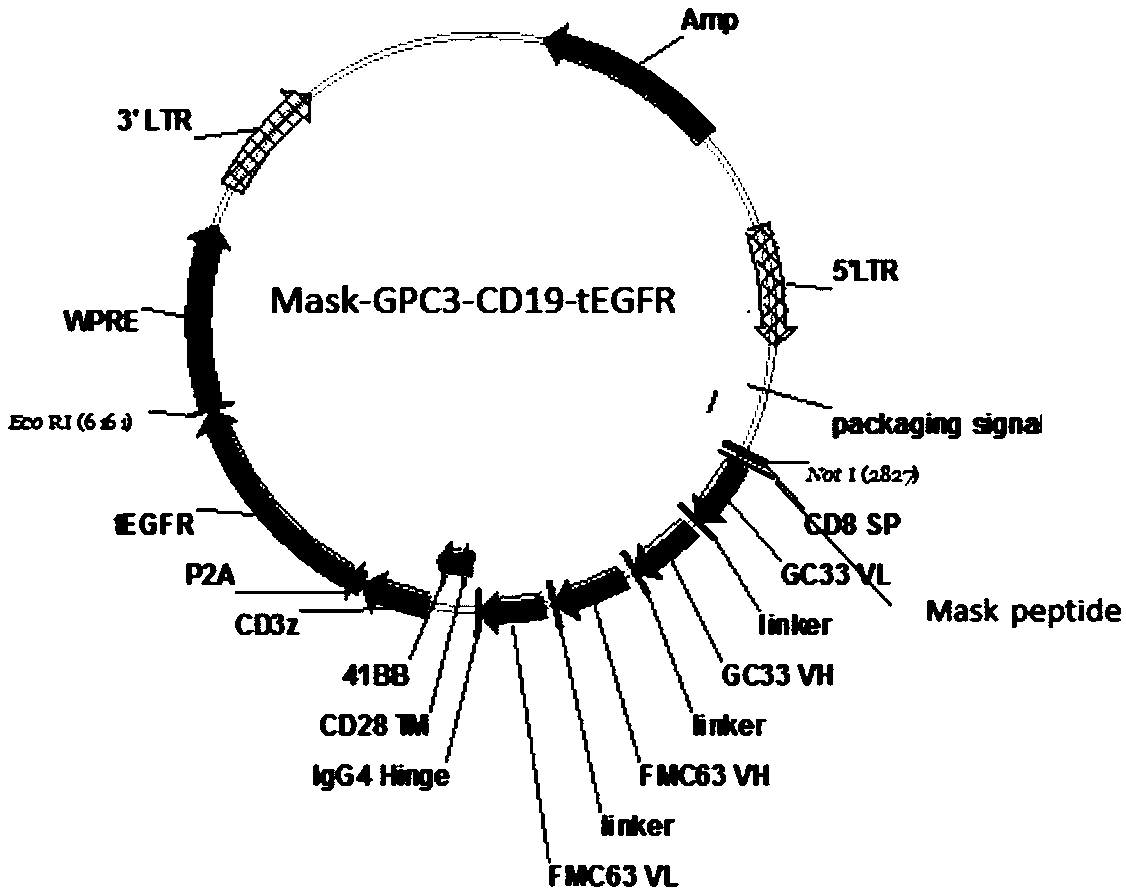Method for constructing novel chimeric antigen receptor targeting dual target points of GPC3 and CD19
An antigen and single-chain antibody technology, applied in the field of cell therapy, can solve the problem that liver cancer cannot be cured.
- Summary
- Abstract
- Description
- Claims
- Application Information
AI Technical Summary
Problems solved by technology
Method used
Image
Examples
Embodiment 1
[0067] Example 1: Determination of MASK-GPC3-CD19-CAR-tEGFR gene sequence
[0068] The heavy chain and light chain variable region gene sequence information (GC33) of the anti-GPC3 antibody was searched from the NCBI website database, and the anti-CD19 antibody heavy chain and light chain variable region gene sequence information (FMC63) sequence was found on the website http: / / sg. Codon optimization is performed on idtdna.com / site to ensure that it is more suitable for human cell expression without changing the encoded amino acid sequence.
[0069] For the nucleotide and amino acid sequence information of each gene, see (SEQUUNCE ID NO.1-2)
[0070] The above sequences were connected in sequence, and different enzyme cutting sites were introduced at the junctions of each sequence to form the complete sequence information of the Mask-GPC3-CD19-IgG4-CD28-41BB-tEGFR gene.
Embodiment 2
[0071] Embodiment 2: the construction of the viral vector comprising the nucleic acid sequence of CAR molecule
[0072] The nucleotide sequence of the CAR molecule prepared in Example 1 was double digested with NotI (NEB) and EcoRI (NEB), connected and inserted into the NotI-EcoRI site of the retroviral RV vector through T4 ligase (NEB), and transformed into When the competent E.coli (DH5α) was obtained, the recombinant plasmid was sent to Shanghai Sangon Biotechnology Co., Ltd. for sequencing, and the sequencing result was compared with the fitted Mask-GPC3–CD19-IgG4-CD28-41BB-tEGFR sequence for verification Is the sequence correct. The sequencing primers are:
[0073] Sense sequence: AGCATCGTTCTGTGTTGTCTC (SEQUENCE ID NO.3)
[0074] Antisense sequence: TGTTTGTCTTGTGGCAATACAC (SEQUUNCE ID NO.4)
[0075] After the sequencing was correct, the plasmid purification kit of Qiagen was used to extract and purify the plasmid, and the plasmid calcium phosphate method of the purifie...
Embodiment 3
[0077] Example 3: Retroviral packaging
[0078] 1. On the first day, the 293T cells should be less than 20 passages and not overgrown. Plate at 0.6*10^6 cells / ml, add 10ml of DMEM medium to a 10cm dish, mix the cells well, and culture overnight at 37 degrees.
[0079] 2. On the second day, the 293T cell confluency reaches about 90% for transfection (usually about 14-18 hours after plating); prepare the plasmid complex, the amount of various plasmids is 12.5ug for Retro backbone (MSCV), and 12.5ug for Gag-pol 10ug, VSVg is 6.25ug, CaCl 2 250ul,H 2 O is 1ml and the total volume is 1.25ml; Add HBS equal to the volume of the plasmid complex in another tube, and vortex for 20 seconds while adding the plasmid complex. Gently add the mixture to the 293T dish along the side, incubate at 37°C for 4 hours, remove the medium, wash with PBS, and re-add fresh preheated medium.
[0080] 3. Day 4: 48 hours after transfection, collect the supernatant and filter it with a 0.45um filter, st...
PUM
 Login to View More
Login to View More Abstract
Description
Claims
Application Information
 Login to View More
Login to View More - R&D
- Intellectual Property
- Life Sciences
- Materials
- Tech Scout
- Unparalleled Data Quality
- Higher Quality Content
- 60% Fewer Hallucinations
Browse by: Latest US Patents, China's latest patents, Technical Efficacy Thesaurus, Application Domain, Technology Topic, Popular Technical Reports.
© 2025 PatSnap. All rights reserved.Legal|Privacy policy|Modern Slavery Act Transparency Statement|Sitemap|About US| Contact US: help@patsnap.com


